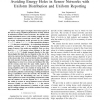Free Online Productivity Tools
i2Speak
i2Symbol
i2OCR
iTex2Img
iWeb2Print
iWeb2Shot
i2Type
iPdf2Split
iPdf2Merge
i2Bopomofo
i2Arabic
i2Style
i2Image
i2PDF
iLatex2Rtf
Sci2ools
INFOCOM
2006
IEEE
2006
IEEE
Design Guidelines for Maximizing Lifetime and Avoiding Energy Holes in Sensor Networks with Uniform Distribution and Uniform Rep
— This paper investigates theoretical aspects of the uneven energy depletion phenomenon recently noticed in sink-based wireless sensor networks. We consider uniformly distributed sensors, each sending roughly the same number of reports toward the closest sink. We assume an energy consumption model governed by the relation E = dα +c where d, (d ≤ tx), is the transmission distance, α ≥ 2 is the power attenuation, c is a technology-dependent positive constant, and tx is the maximum transmission range of sensors. Our results are multifold. First, we show that for α > 2, all sensors whose distance to the sink is min{tx, ( 2c α−2 ) 1 α } should transmit directly to the sink. Interestingly, this limit does not depend on the size of the network, expressed as the largest distance R from a sensor to the closest sink. Next, we prove that in order to minimize the total amount of energy spent on routing along a path originating at a sensor in a corona and ending at the sink, all the...
Closest Sink | Communications | Energy Depletion Phenomenon | INFOCOM 2006 | Uneven Energy Depletion |
| Added | 11 Jun 2010 |
| Updated | 11 Jun 2010 |
| Type | Conference |
| Year | 2006 |
| Where | INFOCOM |
| Authors | Stephan Olariu, Ivan Stojmenovic |
Comments (0)

